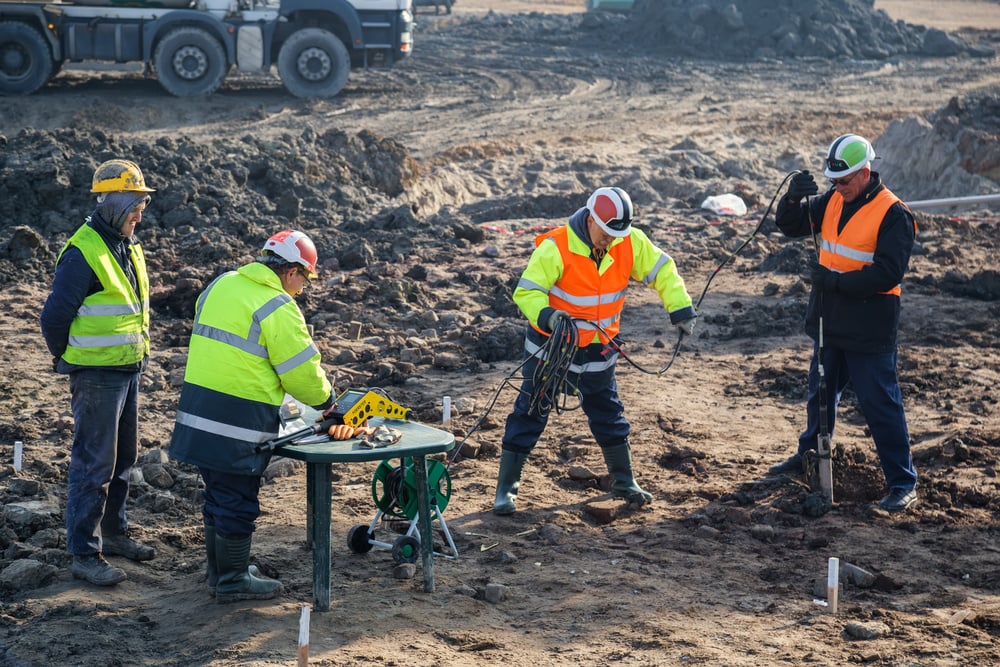3 Easy Facts About Geotechnical Engineering For Construction Projects Described
Geotechnical Engineering For Construction Projects - Truths
Table of Contents3 Simple Techniques For Geotechnical Engineering For Construction ProjectsNot known Facts About Geotechnical Engineering For Construction ProjectsExcitement About Geotechnical Engineering For Construction ProjectsFascination About Geotechnical Engineering For Construction ProjectsWhat Does Geotechnical Engineering For Construction Projects Do?An Unbiased View of Geotechnical Engineering For Construction Projects
The function of geotechnical engineering substantially manages realizing the attributes of dirt and rock, which might vary considerably by their density, wetness web content etc. These attributes must be analyzed by geotechnical engineers to anticipate their motions under different circumstances. The safety and security along with security of frameworks are influenced by soil conditions, making this analysis necessary., in enhancement to exactly how they communicate with constructions that have actually been set up on or within them, is one of the primary descriptions for why geotechnical design is essential.
Along with architectural planning and building, geotechnical engineering is also essential to the reconstruction and maintenance of pre-existing frameworks. Age-related deterioration or added problems might impact a structure's security and efficiency. Environmental security is completed through geotechnical engineering. Competence in air, water, and dirt quality maintenance is put to make use of by geotechnical designers to minimize the unfavorable impacts of tasks.
Facilities advancement, offshore engineering, tunnel building and construction, and deep foundations. Risk-based layout and multidisciplinary teams. These elements will keep the field advancing and ensure its ongoing significance in the years to come. To summarize, geotechnical design is an important self-control that preserves the strength and stability of civil framework. Geotechnical designers contribute to making building jobs effective throughout the globe by understanding the behavior of earth products and using ideal planning approaches.
The 5-Minute Rule for Geotechnical Engineering For Construction Projects
The foundational security of any type of task is vital. Geotechnical design plays an essential function in making sure that structures are built on strong ground, literally and figuratively. By checking out soil, rock, and subsurface conditions, geotechnical designers provide important understandings that help in the layout, building, and maintenance of structures and framework.

Some Known Details About Geotechnical Engineering For Construction Projects
Lab screening: Determining the properties of soil and rock. Area testing: Carrying out tests on-site to assess conditions. Analysis and layout: Utilizing data to create structures, preserving wall surfaces, passages, and various other frameworks. A number of prominent building and construction projects have actually efficiently used geotechnical useful site engineering to ensure their security and safety and security. :: The globe's highest structure called for a deep understanding of the underlying geology.

As a leader in geotechnical design, BECC Inc. is committed to delivering cutting-edge and reliable site link services that satisfy the highest standards of top quality and safety. For more details on just how BECC Inc. can support your following building and construction task, contact us today and allow us assist you build on strong ground.
William Rankine, an engineer and physicist, created an alternate to Coulomb's earth stress theory. Albert Atterberg created the clay uniformity indices that are still used today for dirt classification. In 1885, Osborne Reynolds identified that shearing reasons volumetric expansion of dense products and contraction of loose granular products. Modern geotechnical engineering is claimed to have started in 1925 with the publication of Erdbaumechanik by Karl von Terzaghi, a mechanical designer and geologist.
Geotechnical Engineering For Construction Projects - An Overview
Terzaghi also developed the framework for theories of birthing capacity of structures, and the theory for prediction of the rate of settlement of clay layers because of loan consolidation. Afterwards, Maurice Biot completely established the three-dimensional dirt loan consolidation theory, prolonging the one-dimensional design formerly developed by Terzaghi to much more general hypotheses and presenting the collection of fundamental equations of Poroelasticity.
Geotechnical engineers explore and figure out the residential or commercial properties of subsurface problems and products.
The 4-Minute Rule for Geotechnical Engineering For Construction Projects
Geologic mapping and analysis of geomorphology are normally finished in assessment with a geologist or engineering geologist. Subsurface exploration typically includes in-situ testing (for instance, the standard penetration test and cone penetration examination). The digging of test pits and trenching (particularly for locating faults and slide planes) may also be utilized to learn more about dirt problems at depth. , which utilizes a thick-walled split spoon sampler, is the most typical method to gather disturbed examples.

Typically, the user interface's precise geometry is unknown, and a streamlined interface geometry is thought. Limited inclines need three-dimensional models to be analyzed, so most inclines are evaluated thinking that they are definitely broad and can be stood for by two-dimensional versions.
Things about Geotechnical Engineering For Construction Projects
The observational technique might be called adheres to: General expedition adequate to develop the rough nature, pattern, and residential properties of down payments. Analysis of one of the most potential conditions and the most unfavorable conceivable variances. Developing the design based on a working hypothesis of habits prepared for under one of the most potential problems. Option of amounts to be observed as construction proceeds and calculating their expected worths based upon the working hypothesis under the most undesirable conditions.
Dimension of amounts and evaluation of real problems. Design modification per real problems The observational technique appropriates for building that has currently begun when an unforeseen advancement happens or when a failure or crash looms or has currently occurred. It disagrees for jobs whose style can not be altered throughout building.